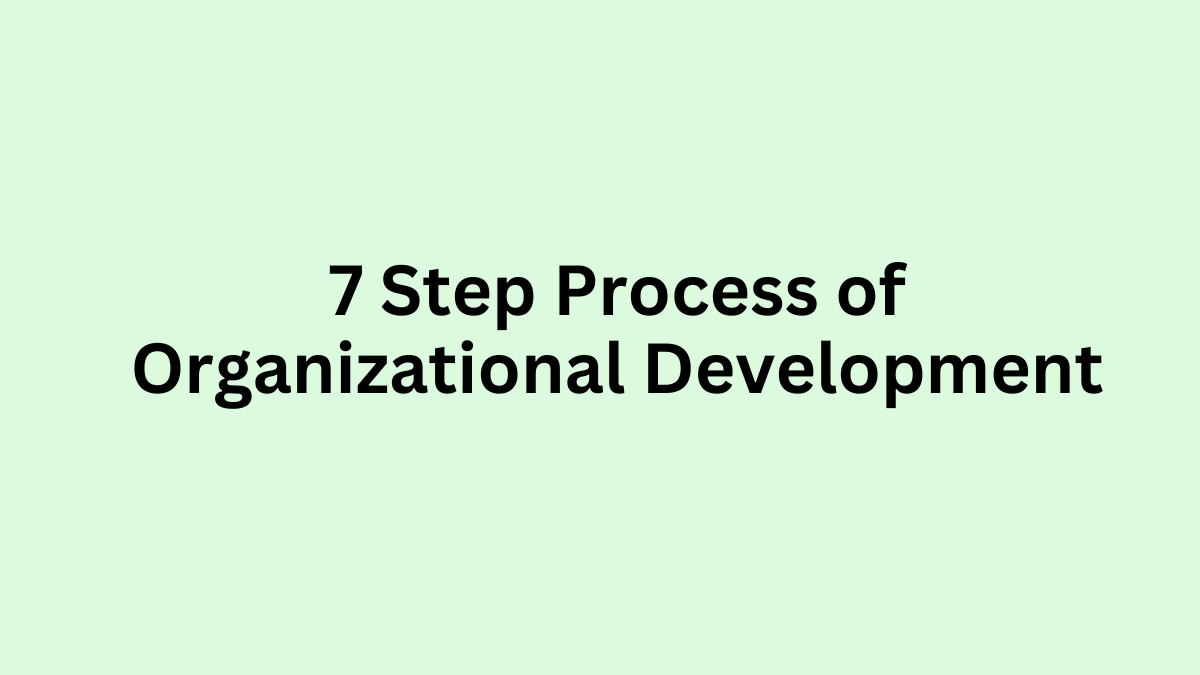Process of Organizational Development
The organizational development process is a strategic endeavor aimed at enhancing an organization’s overall effectiveness and functionality. It unfolds through a systematic series of steps, each playing a crucial role in fostering positive change.
Let’s explore the seven key steps of the organizational development process:
Problem Identification
At the beginning of organizational development lies the critical step of problem identification. Often initiated by top management, this phase involves a meticulous examination of the organization’s landscape to recognize areas that need change.
It’s a proactive approach, driven by a commitment to continuous improvement and a keen awareness of the evolving dynamics within and outside the organization.
In this initial step, leaders and key stakeholders engage in a collaborative process to pinpoint challenges, inefficiencies, or growth opportunities. This identification sets the foundation for the subsequent stages of the organizational development journey.
Data Collection
With problem areas identified, the next step in the OD process involves a comprehensive data collection process. This phase seeks to gather relevant and detailed information related to the identified problems. The goal is to delve deep into the intricacies of organizational dynamics, processes, and employee perceptions, ensuring a holistic understanding of the challenges at hand.
Various methods, such as surveys, interviews, and data analysis, are employed to paint a detailed picture of the organizational landscape. The richness of the collected data serves as the raw material for the subsequent stages of analysis and decision-making.
Feedback
Armed with a trove of data, the organizational development journey takes a collaborative turn in the feedback phase. This step involves sharing the analyzed information with organizational members and creating a platform for validation and additional insights.
Transparency and inclusivity are key pillars during this stage, fostering a sense of ownership and shared responsibility for the organizational development process.
Feedback sessions become forums for dialogue, where diverse perspectives merge to refine the understanding of the identified problems. This iterative process sets the stage for the co-creation of solutions and establishes a foundation of trust and collaboration within the organizational ecosystem.
Action Plan Development
With validated insights and a shared understanding of the challenges, the organizational development process advances to the action plan development stage. This phase is akin to crafting a roadmap for change, where leaders and stakeholders collaboratively formulate a comprehensive action plan.
The action plan goes beyond mere identification of solutions; it involves evaluating different alternatives and selecting the most effective course of action.
Considerations such as resource allocation, timelines, and anticipated outcomes are intricately woven into the fabric of the plan. It becomes a strategic document that not only addresses the identified problems but also aligns with the broader goals and vision of the organization.
Read More: 5 Key Values of Organizational Development
Implementation
The meticulously crafted action plan transitions from theory to reality in the implementation phase. This step is characterized by the execution of planned activities, with a clear illustration of roles and responsibilities. The successful implementation of the action plan hinges on effective communication, collaboration, and adaptability.
Leadership plays a pivotal role in steering the organization through this transformative phase. Clear communication channels, continuous monitoring, and a responsive approach to unforeseen challenges are essential elements during the implementation stage. It’s a dynamic process where the organization actively engages with change, fostering a culture of agility and resilience.
Evaluation
As change permeates the organizational structure, the evaluation phase takes center stage. This step involves a continuous assessment of the impact of the organizational development process on various facets of organizational performance and effectiveness. Evaluation is not a one-time event but an ongoing process, intricately woven into the organizational DNA.
Read More: 8 Steps To Implement Change in the Organization
Key performance indicators, feedback loops, and data analytics contribute to the evaluative process. The objective is to gauge the effectiveness of implemented changes, identify areas of success, and pinpoint opportunities for refinement. Evaluation becomes a compass guiding the organization, ensuring that the trajectory aligns with the intended goals and objectives.
Continuous Improvement
The culmination of one cycle in the organizational development process marks the beginning of another. Continuous improvement is not just a step; it’s a guiding principle woven into the very structure of organizational development. Embracing a cyclical approach, organizations foster a culture of ongoing enhancements and adaptability to evolving needs.
Continuous improvement involves learning from experiences, both successes and setbacks. It encourages a mindset of curiosity and a commitment to staying attuned to emerging trends and challenges. Leaders play a pivotal role in nurturing this iterative culture, empowering teams to embrace change as a constant and dynamic force.
Hence, these are the 7 key steps in the process of OD.
Read Next: What is Resistance To Change?

Sujan Chaudhary holds a Bachelor in Business Administration (BBA) degree and is currently pursuing an MBA degree. He loves to share his business knowledge with the rest of the world.
